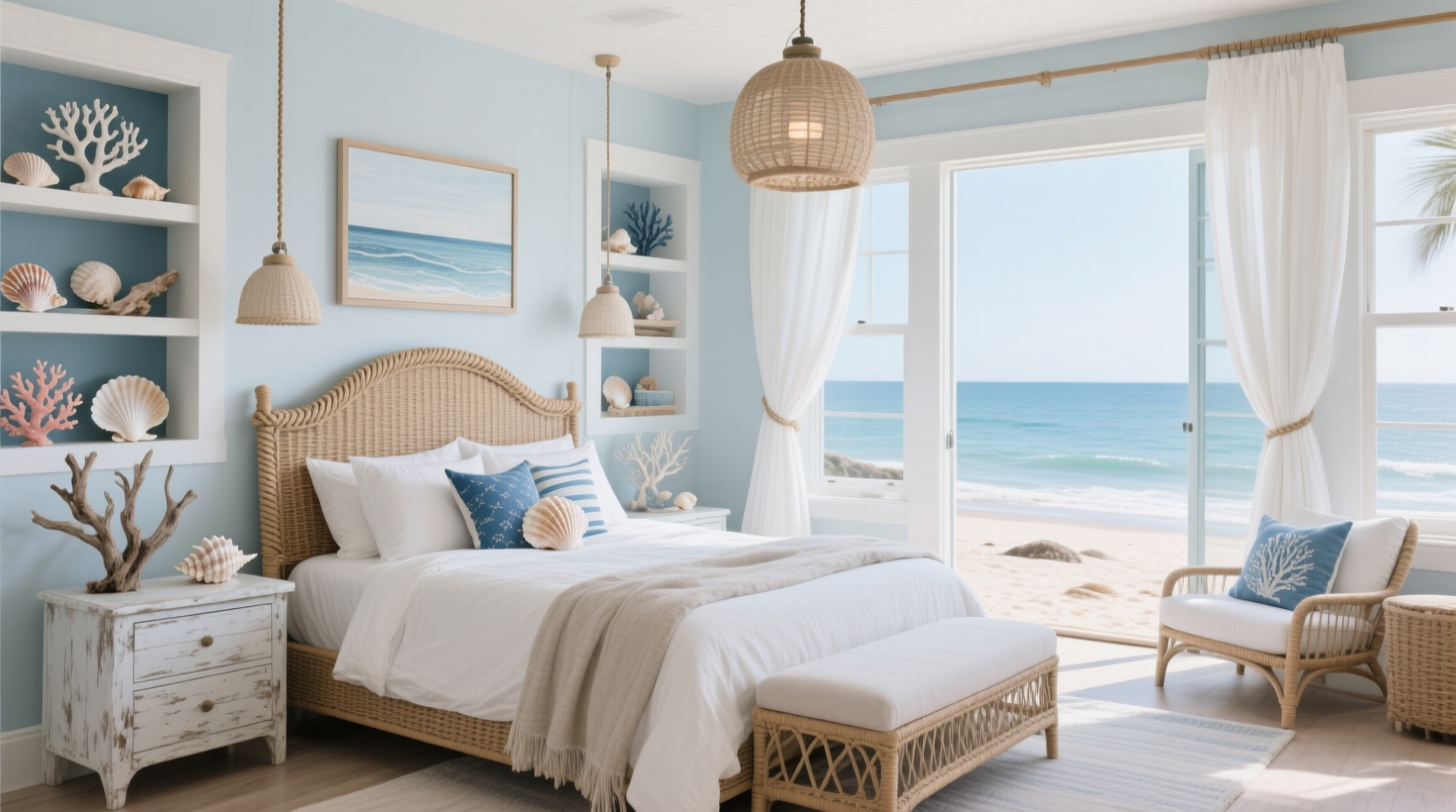Coastal bedrooms don’t need to live by the water. You can feel the ocean even if you’re a thousand miles from it. The trick is knowing which little details pull the beach inside without it looking like a souvenir shop exploded.
Some people think coastal style means seashell lamps and a fishing net pinned to the wall. Not true. It’s softer. It’s about light, textures, and a calmness that drifts in like tidewater. If you’ve ever stepped into a room that made you breathe a little slower, that’s the feeling we’re after.
Below are 20+ ideas to give your master bedroom that kind of breezy magic. They aren’t cookie-cutter tips. They’re layers you can play with until your space feels like sand under bare feet.
1. Keep the palette pale and breathable
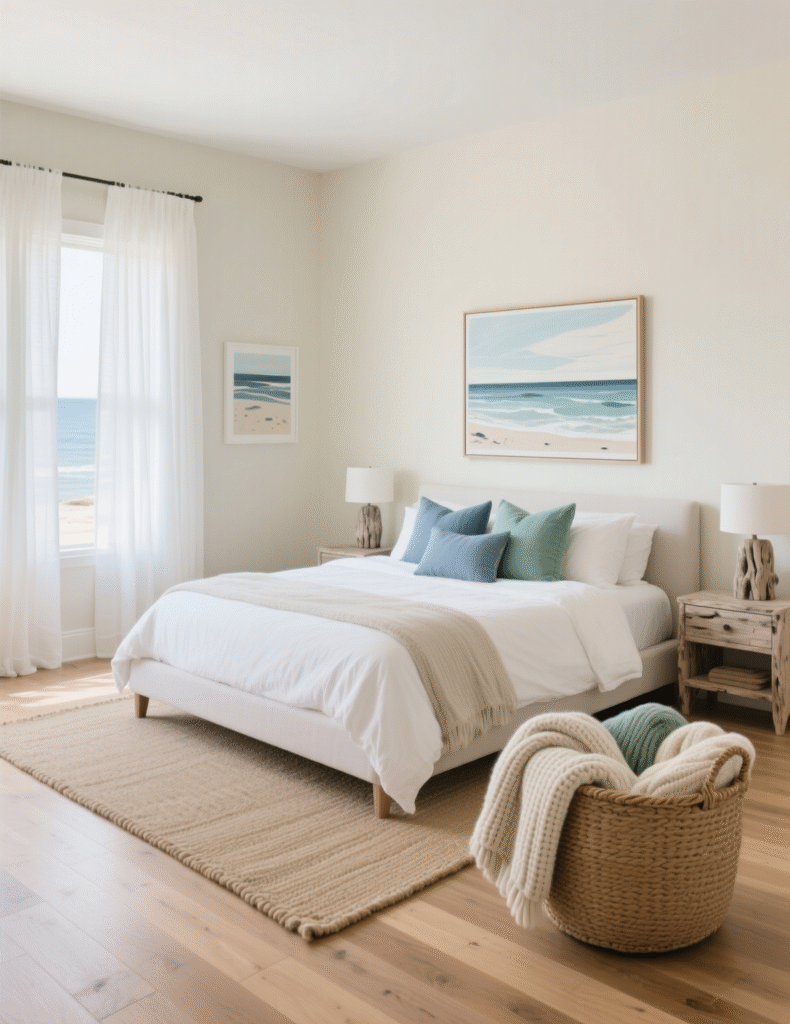
The first thing the coast teaches you is color. White sand, sun-bleached driftwood, seafoam, and storm clouds. Your bedroom needs that same palette.
Walls in soft white or pale beige become your canvas. Then bring in sea-glass greens or powdery blues. Don’t go neon ocean blue—it feels fake, like plastic flip-flops. Instead, let the colors whisper. Think of the horizon at dawn, not a beach ball.
Even if your space is small, pale walls bounce the light and stretch the room wider. And when you wake up, the morning sun feels like it belongs there.
2. Layer textures that echo nature
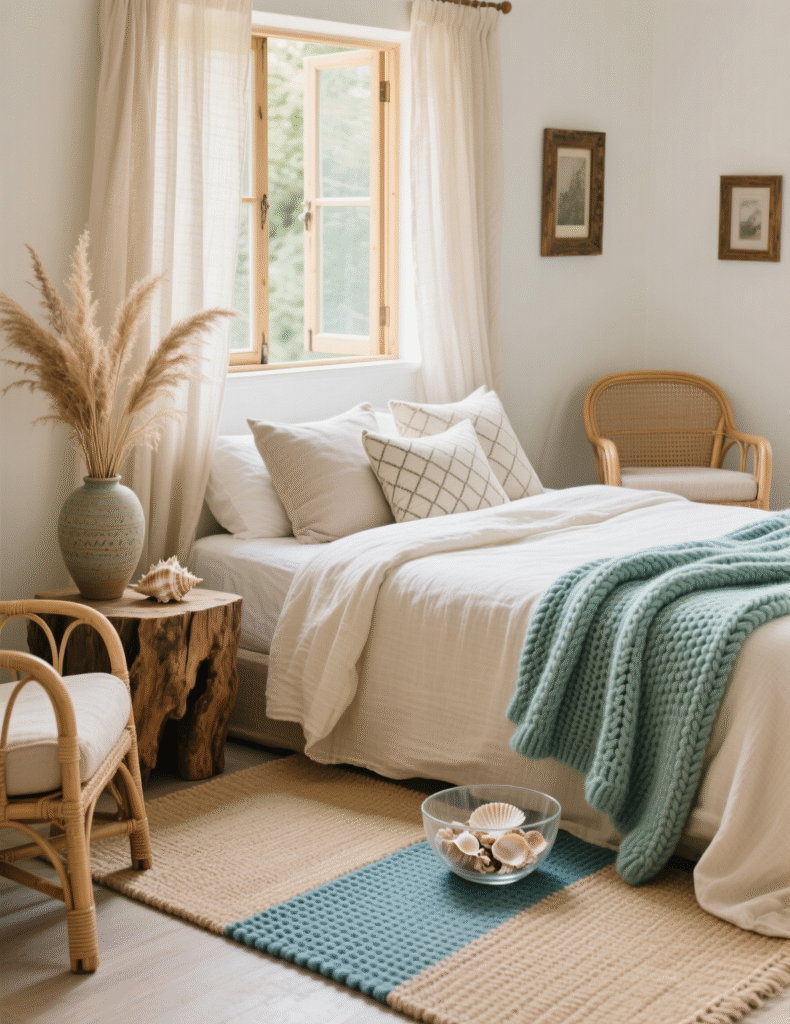
Texture is where coastal design really sings. A linen duvet feels crumpled in the best way. A jute rug underfoot feels rough like sand but warmer. A rattan chair in the corner gives the room its own tidepool of interest.
Don’t be afraid to mix. Cotton sheets, a chunky knit throw, a cane headboard. The point is to keep it casual but not messy. You want the room to look lived in, like someone took a nap and left the window open.
Even furniture with slight imperfections—distressed wood, wicker with a loose strand—adds character. It’s like driftwood. Nature doesn’t sand everything smooth, and neither should you.
3. Invite natural light like it’s a guest
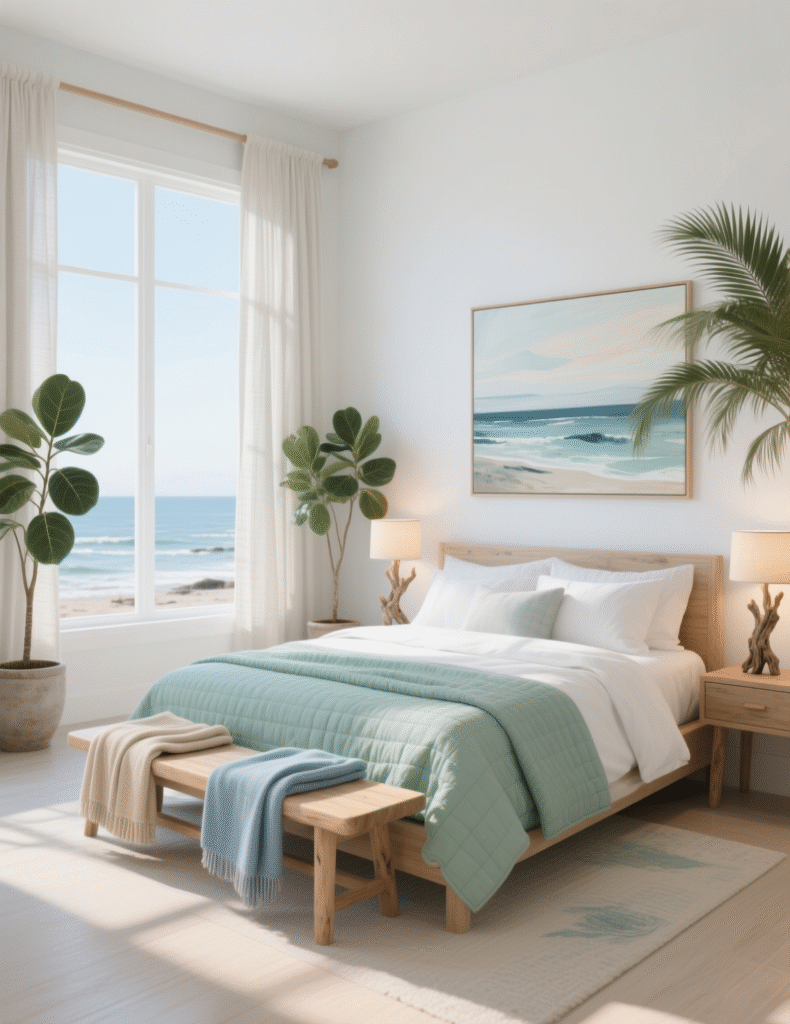
Sunlight is the cheapest and most honest design tool. Coastal bedrooms crave it. Heavy curtains that block it out are like a locked door on a summer afternoon.
Choose sheer linen drapes or even bamboo blinds that let the glow sneak through. The shadows they cast in the room feel alive. If privacy’s a must, layer them with light-filtering shades instead of thick blackout panels.
The room changes with the sun. Morning is gentle and silver, evenings glow golden. Let that rhythm be part of your bedroom’s personality.
4. Add touches of driftwood and reclaimed pieces
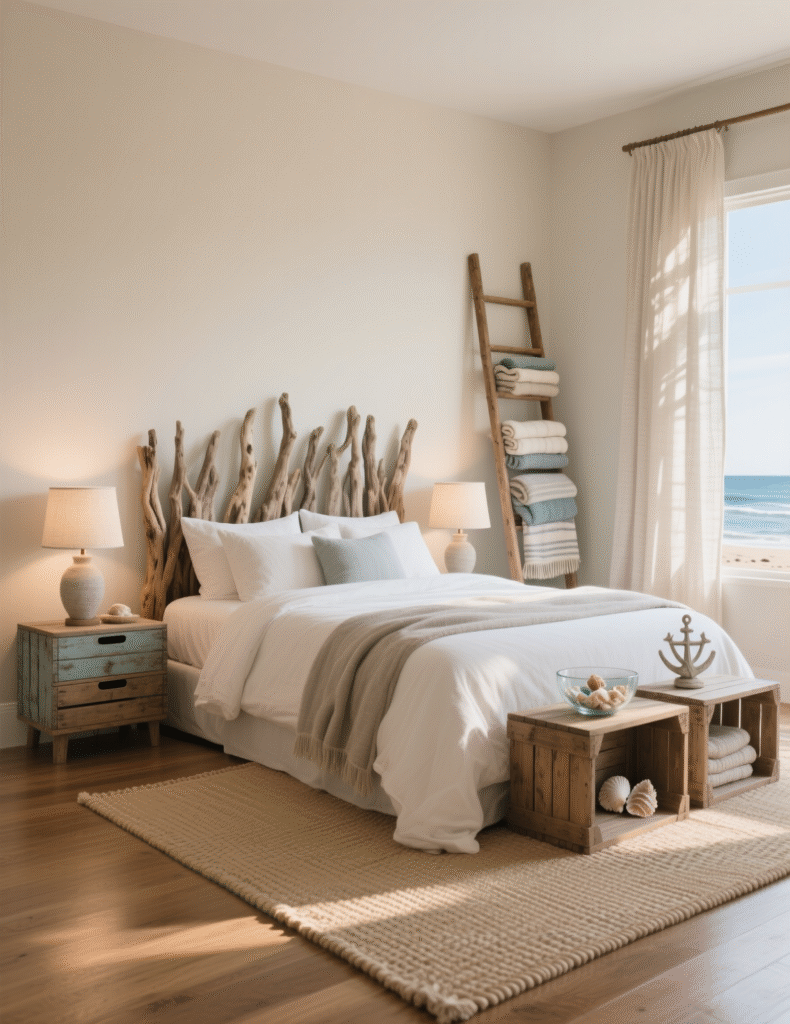
One driftwood lamp can change the entire mood. A weathered dresser with uneven grain can look like it’s been kissed by saltwater. These kinds of pieces ground the space.
You don’t need an entire set of “coastal furniture.” One statement piece does more than five matching ones. An old bench at the foot of your bed, maybe painted once and now chipped, adds story.
The best thing? They don’t have to be perfect. Imperfection is charm here. A scratch in the wood becomes part of the narrative. It’s not about showroom newness—it’s about memory.
5. Choose art that feels open and free
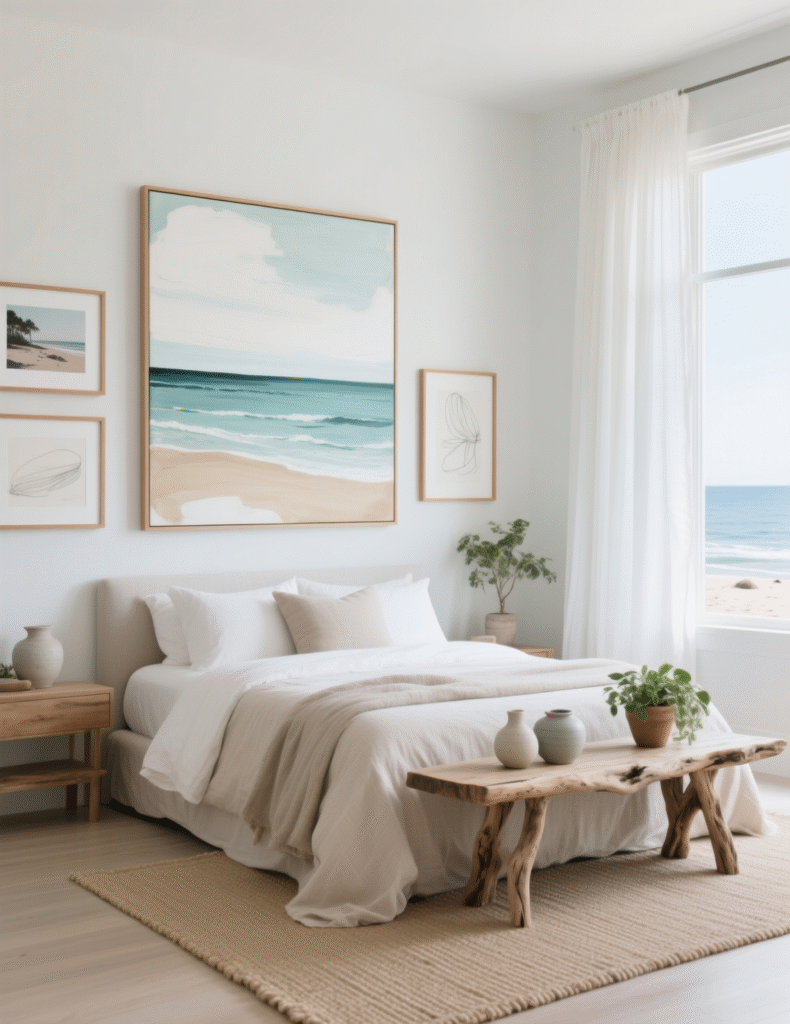
Skip the obvious starfish painting. Coastal art is about feeling, not literal reminders. A wide abstract canvas in soft blues can suggest the horizon. A black-and-white photograph of waves crashing feels timeless.
Try hanging one oversized piece instead of cluttering walls with many. It gives space to breathe. Bedrooms should be restful, not galleries stuffed with frames.
If you love personal touches, frame a map of your favorite coastline or a photo from a beach trip. That way, the room isn’t just coastal—it’s your coast.
6. Bring in subtle nautical hints, not themes
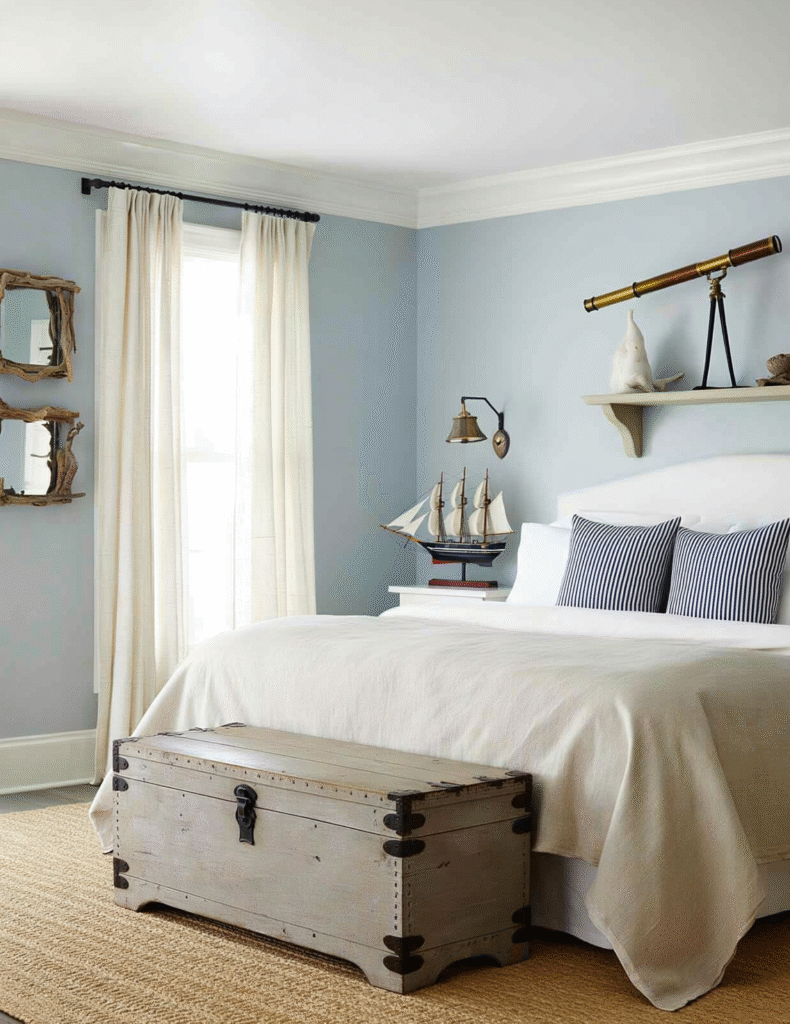
You don’t want your bedroom looking like a sailor’s tavern. Rope and anchors are fine in tiny doses. Maybe a rope-handled basket or a striped throw pillow. That’s enough.
Stripes, especially in navy or faded blue, bring quiet rhythm to the space. But keep them thin, not carnival bold. When in doubt, less is better.
The idea is to nod at the ocean, not shove it in someone’s face. Coastal design should whisper “sea,” not yell it.
7. Use greenery like it grew there naturally
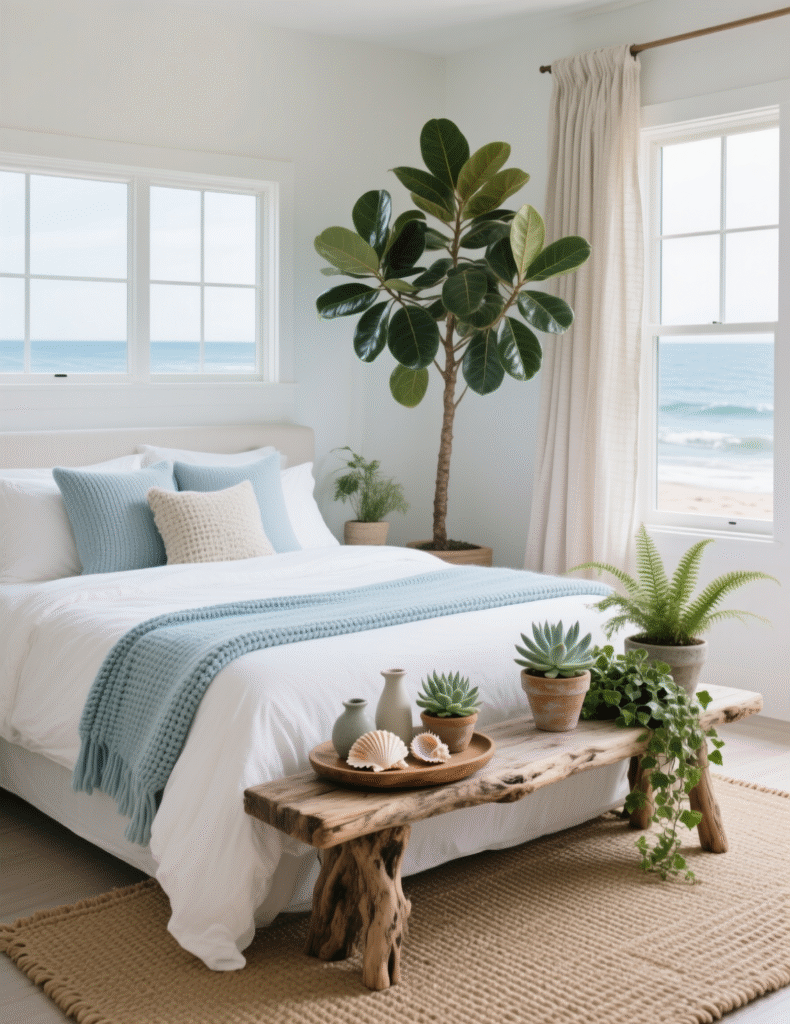
Plants do wonders. A big palm in the corner leans toward the sun and makes the room feel alive. Even a simple vase with eucalyptus stems on the nightstand adds freshness.
Stick with greenery that feels wild and effortless. Nothing too manicured. Let the leaves spill a little over the pot. It keeps the mood loose, like the breeze rearranged it.
Bonus: plants also clean the air, so the room literally feels fresher. You can almost imagine ocean salt drifting through the leaves.
8. Think comfort first, style second
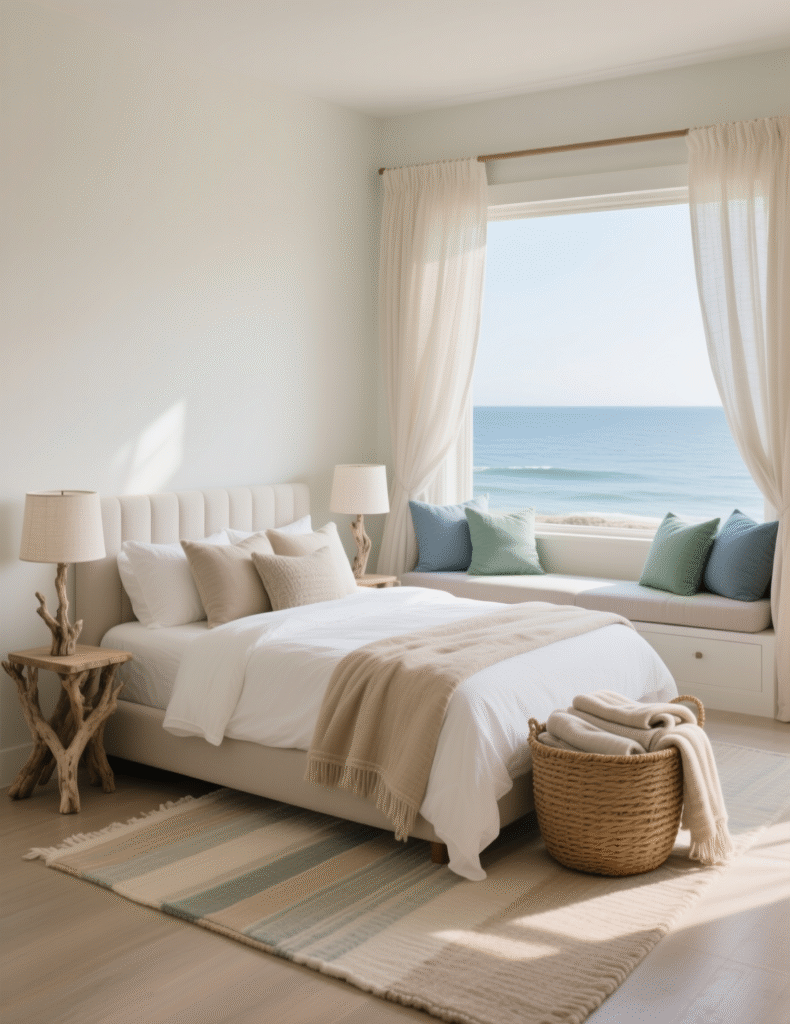
A coastal master bedroom isn’t meant to impress strangers. It’s meant to soothe you at the end of the day. That means comfort first.
Invest in bedding that feels good on bare skin. Soft, breathable cotton or linen works best. Keep extra throws nearby, so you can layer depending on the season.
The more relaxed you are, the more the room feels like a sanctuary. Don’t chase perfection. Comfort is the real coastal luxury.
9. Incorporate soft lighting for evenings
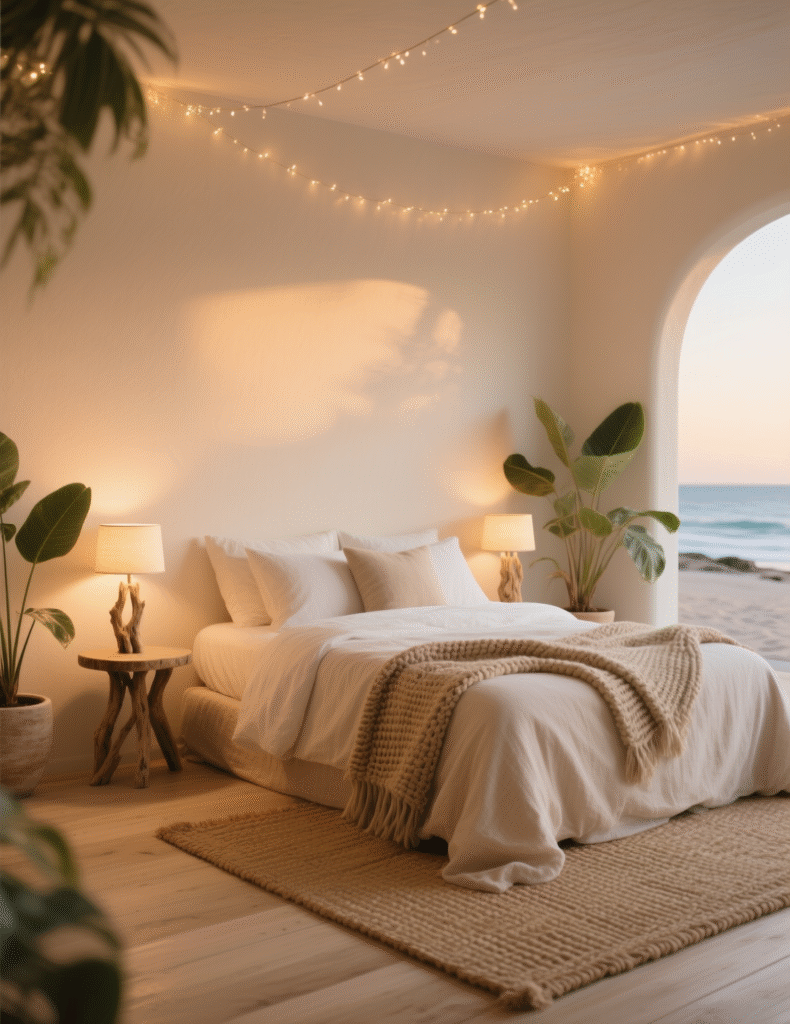
Overhead lighting kills the mood. Swap it for warm table lamps, wall sconces, or even a pendant wrapped in natural fibers. You want the glow to feel like sunset.
Candles work too, especially in glass jars that flicker like reflections on water. Just one candle can shift a bedroom’s tone from bright to calm.
Dimmer switches are your friend. The light should match the rhythm of your day, softening as night rolls in.
10. Personalize with collected treasures
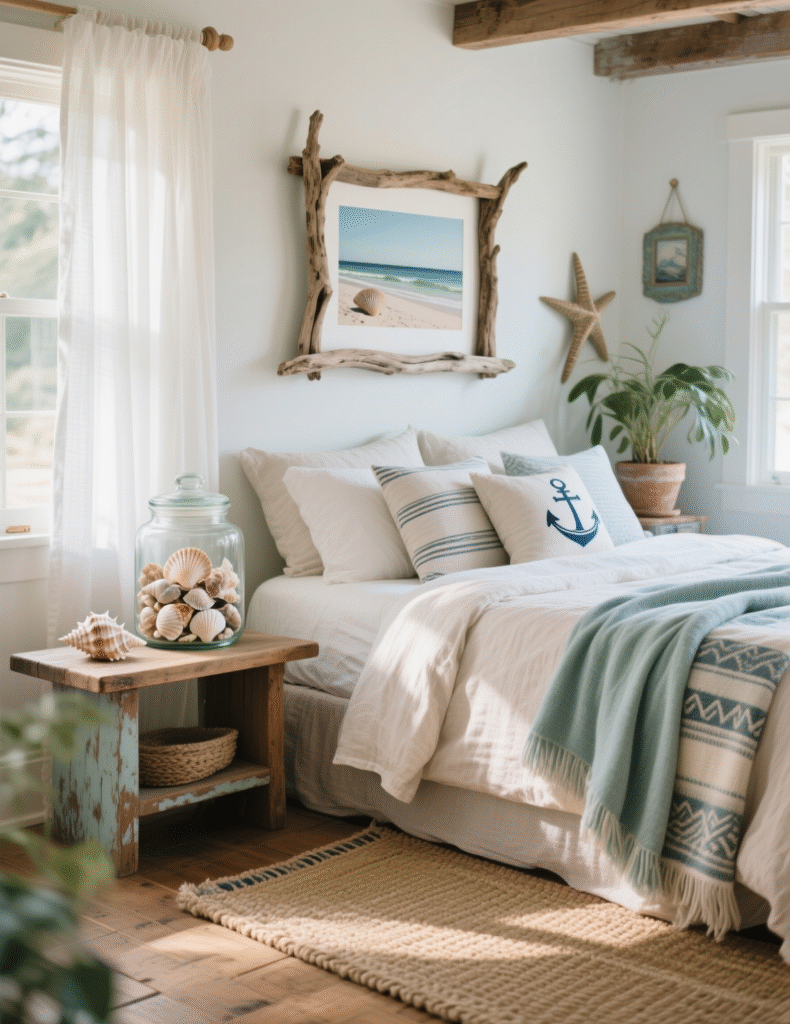
The last touch? Make it yours. A coastal bedroom shouldn’t look like a hotel. It should carry pieces of you.
Maybe it’s a jar of seashells from a trip, or a handwoven blanket you picked up at a local market. Small treasures hold energy. They remind you of stories.
Scatter them lightly. One on a nightstand, another on a shelf. The room should whisper little secrets, not announce them loudly.
11. Embrace negative space like the shoreline does
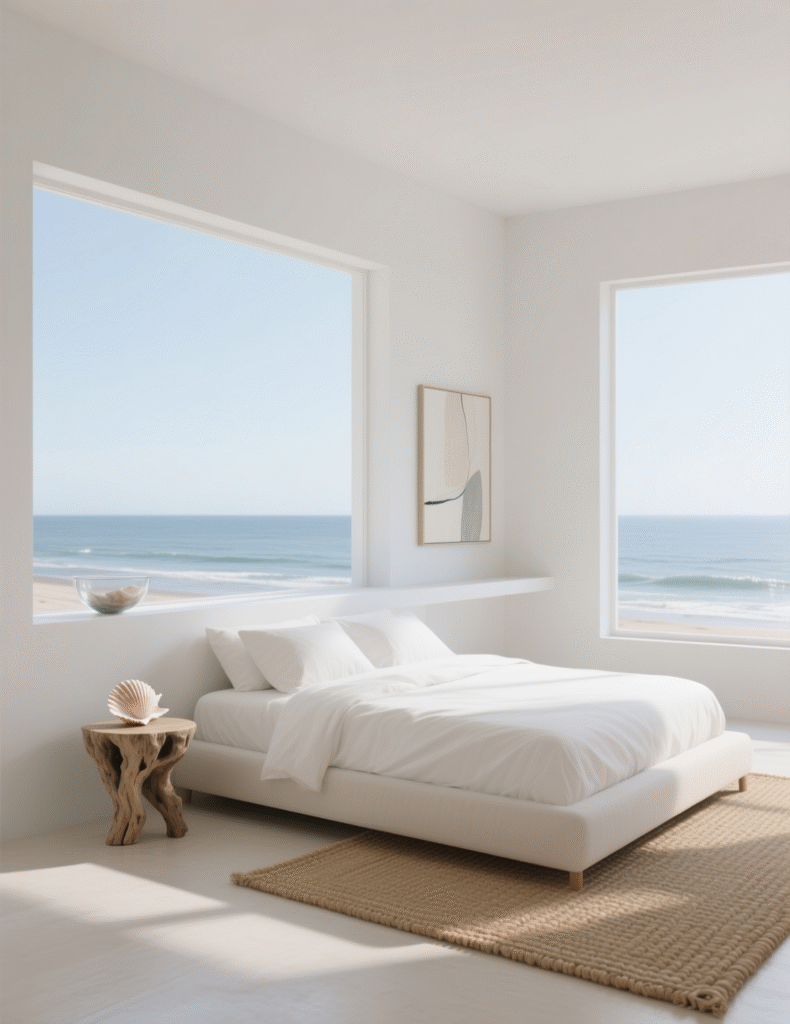
Coastal bedrooms breathe because they’re not stuffed. Empty space is design too. If every surface is covered, the room feels heavy, not airy.
Think of a beach at low tide: wide, open, uninterrupted. Leave some walls bare. Keep a corner uncluttered. The emptiness feels just as important as the pieces you do include.
12. Play with weathered metals
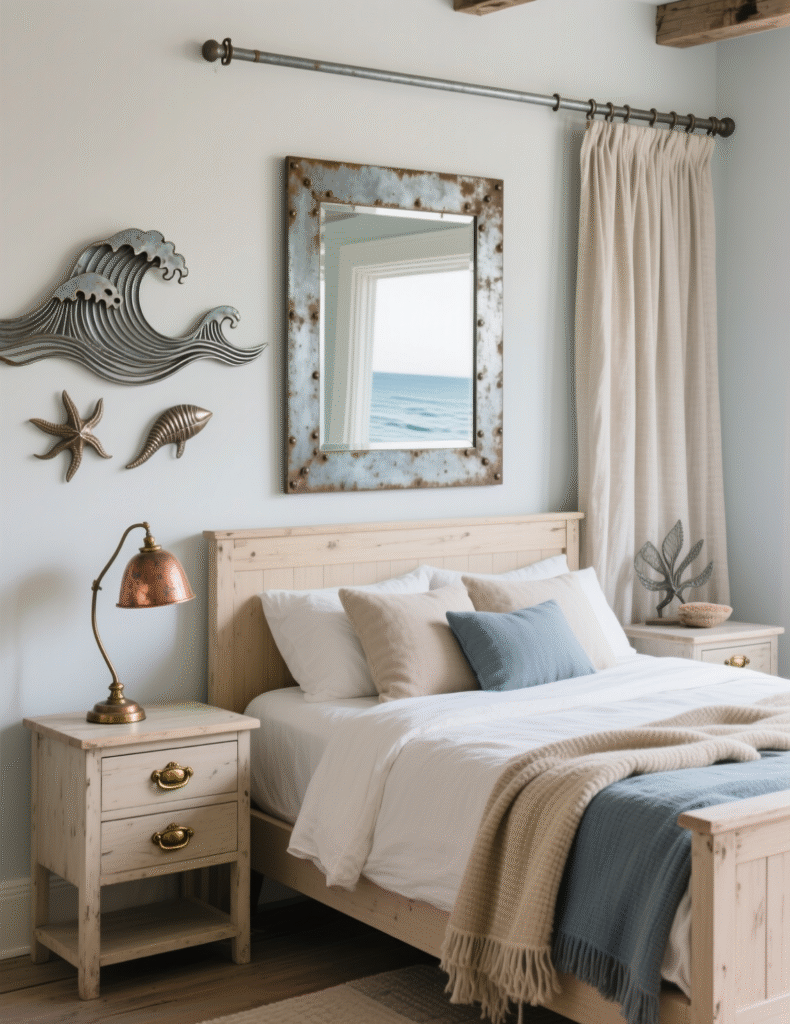
Most people forget metals when decorating coastal. But bronze, brushed nickel, or even matte black fixtures can shift the mood.
Imagine a bedside lamp with a brass base, a doorknob that looks aged by sea air. Those small accents feel quietly nautical, without needing to scream “anchor.”
The shine shouldn’t be polished. A little patina makes it believable, like it’s been outside near saltwater.
13. Use scents to finish the atmosphere
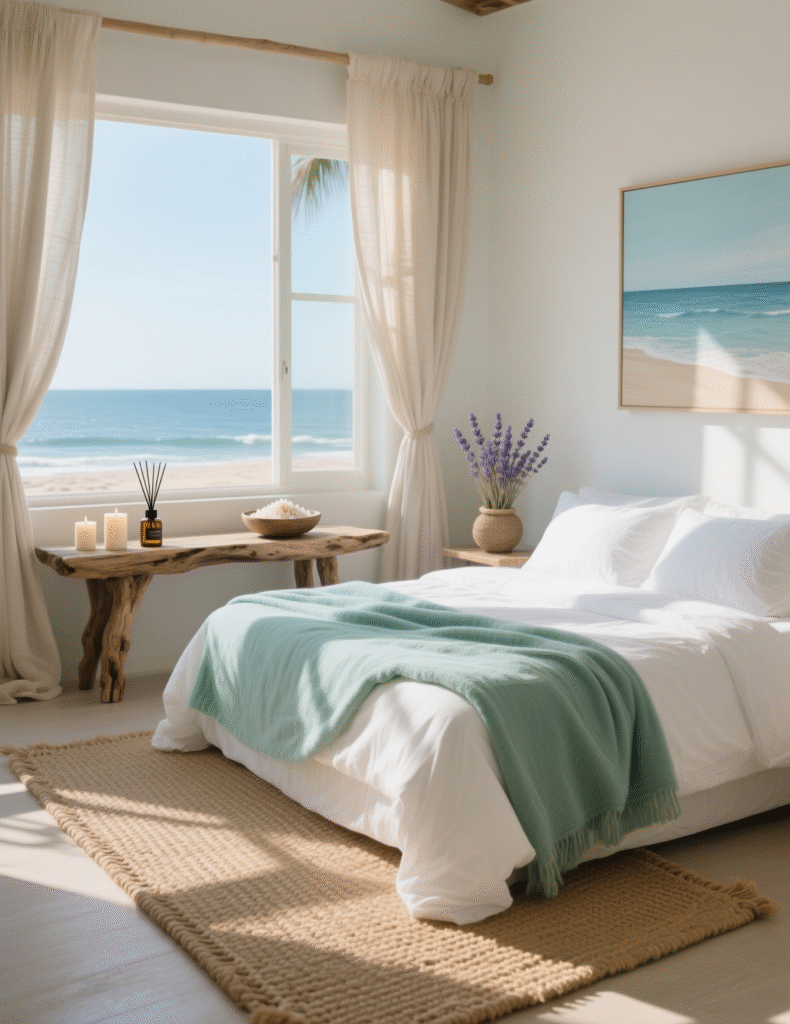
Coastal design isn’t only visual—it’s sensory. A candle with sea salt and sage, or an essential oil diffuser with eucalyptus, can trick the brain into smelling the ocean.
Fresh linen sprays on bedding add another layer. Even a bowl of dried lavender brings that calm, clean air vibe.
The nose remembers spaces long after the eyes forget.
14. Add stone or shell-inspired accents
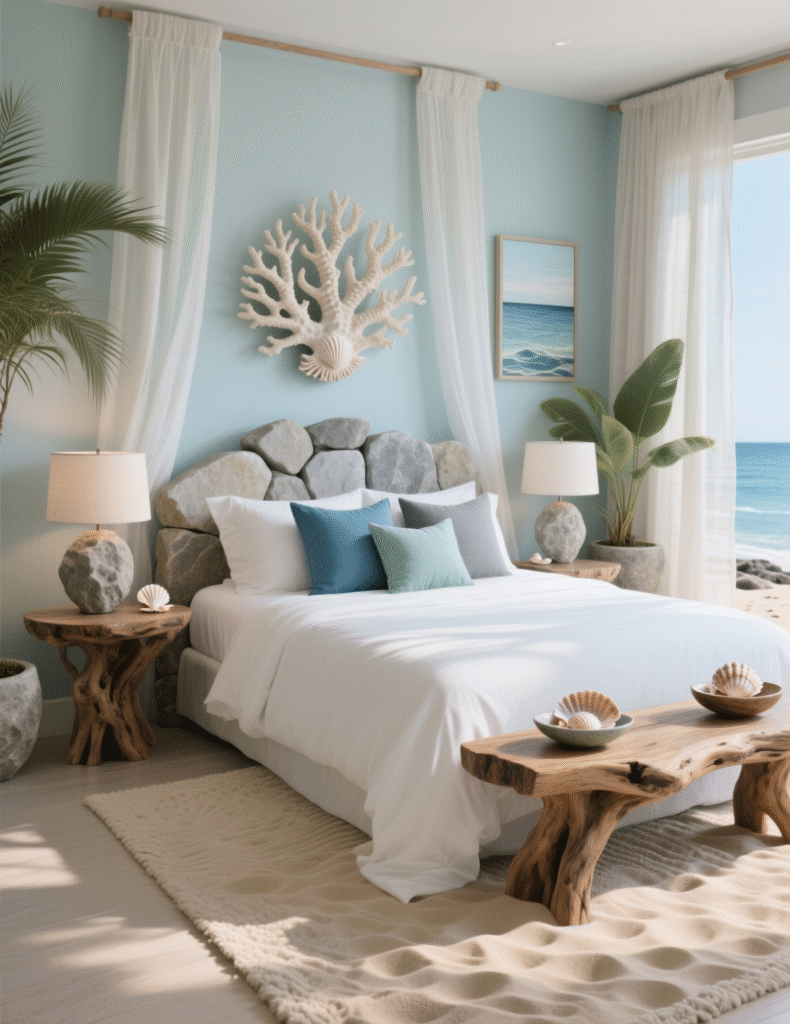
A side table with a marble top feels like smoothed rock from the shore. A lamp base in alabaster gives that cool, chalky look.
Shells don’t need to be literal. Patterns inspired by scallops or clamshell curves can appear on fabrics or mirrors. Subtle references often land better than actual shells scattered around.
The goal is to echo the earthiness of the coast, not mimic it exactly.
15. Create a canopy effect with light fabrics
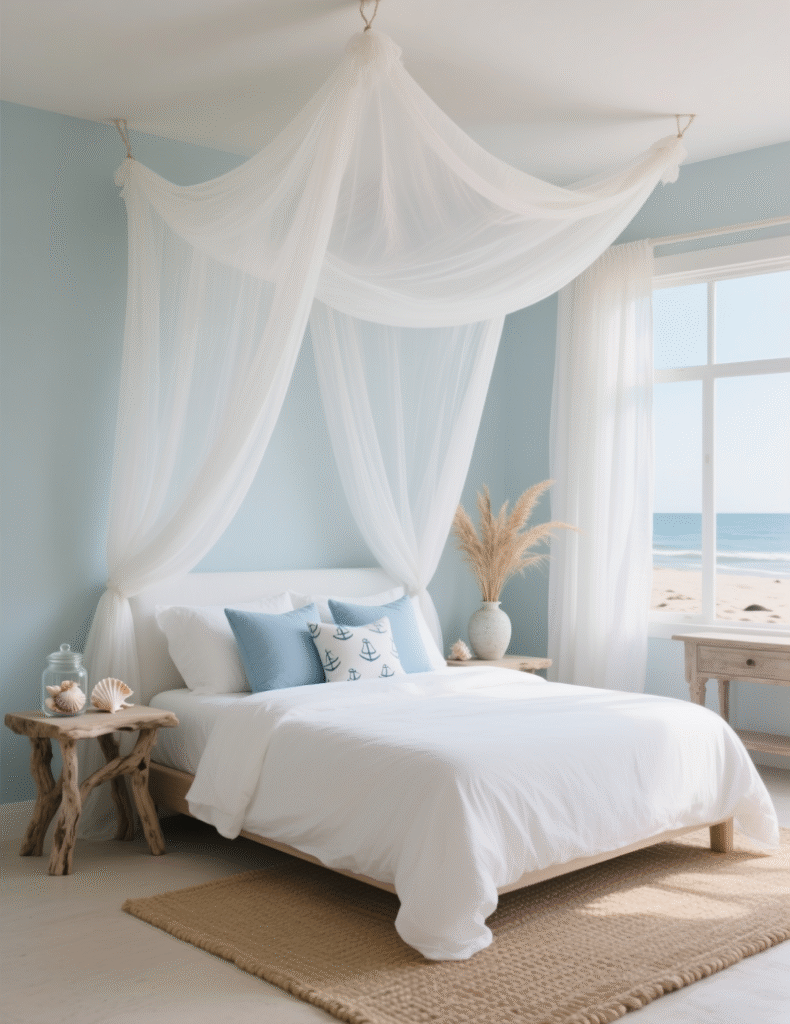
If your bed frame allows, drape sheer white fabric around it. The look is breezy, like sleeping in a beach cabana.
It softens the edges of the room and adds a sense of privacy. At night, the fabric catches the lamplight and glows softly.
Even without a canopy frame, you can hang fabric from the ceiling corners for that floating effect.
16. Use mirrors to bounce light like water
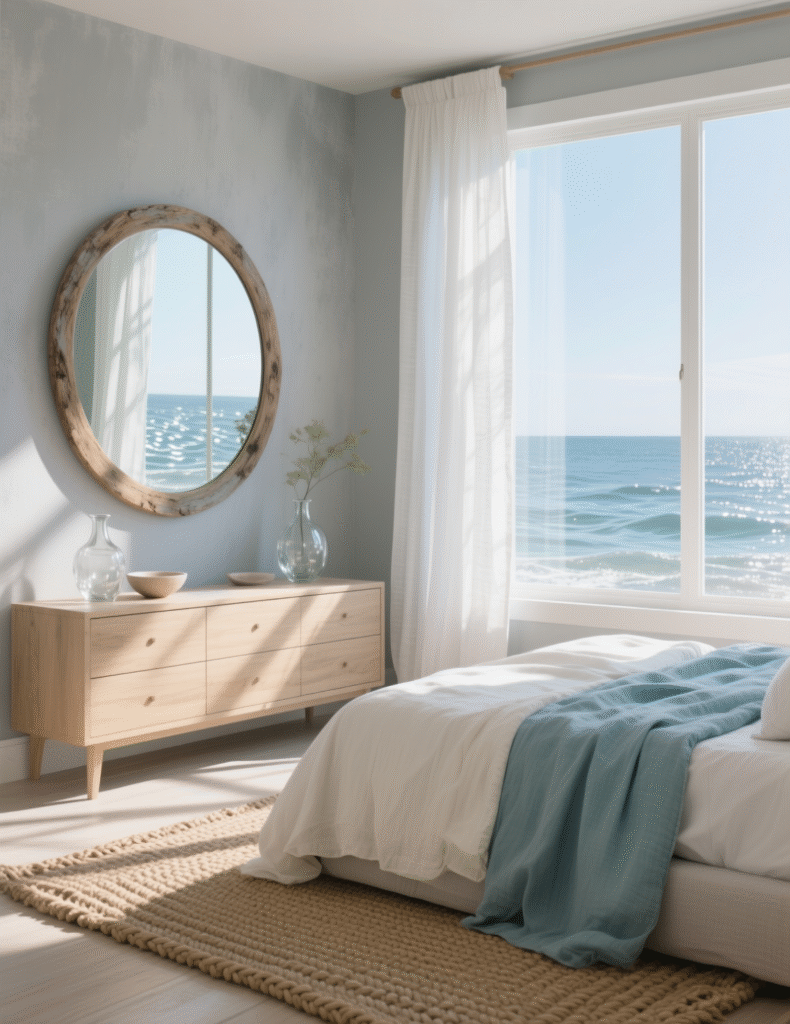
Mirrors aren’t just practical; they can mimic the sea. A large round mirror above the bed looks like a rising sun. Multiple small mirrors catch light and scatter it like ripples.
Choose frames in driftwood, rope, or whitewashed finishes. When sunlight hits, the reflection feels alive, like the surface of waves.
It’s a trick that makes a small room look bigger, too.
17. Layer sound into the room

Silence can be heavy in bedrooms. Coastal spaces thrive on subtle background sound.
A small tabletop fountain adds trickling water, like a tidepool. Even a Bluetooth speaker playing gentle ocean waves at night creates atmosphere.
Sound can be design too—it shapes mood as much as light or color.
18. Add a hammock or hanging chair
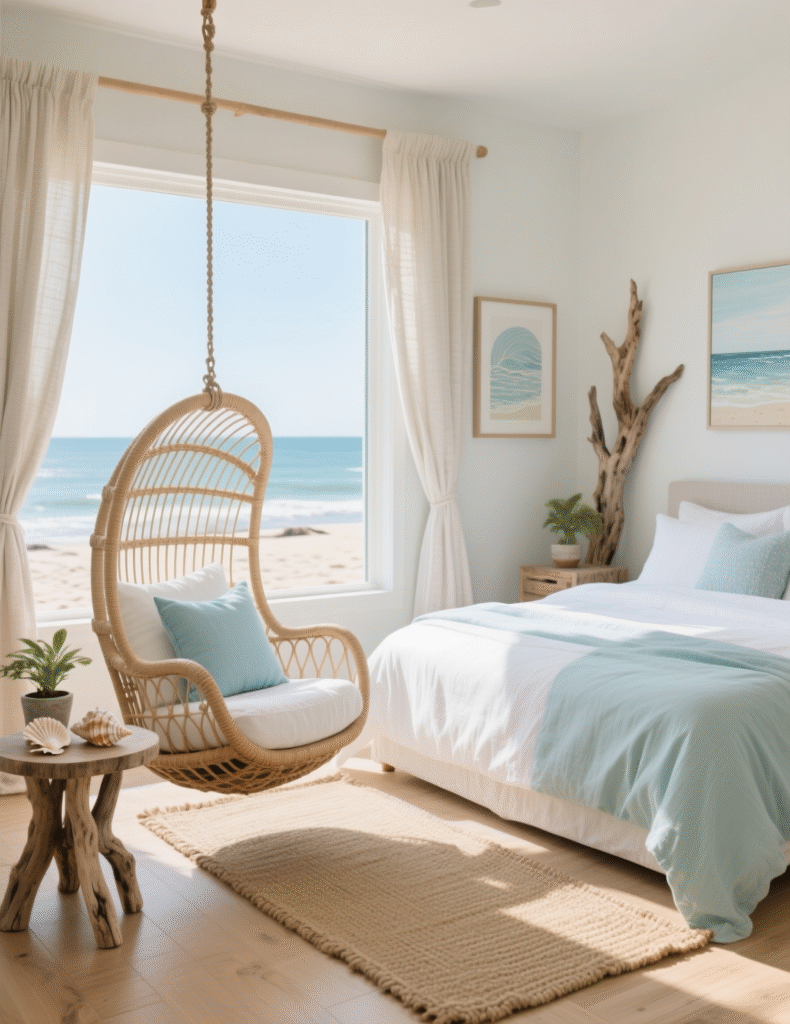
Not every master bedroom allows this, but if you have the space, a hanging chair or hammock is pure coastal.
It creates a nook for reading or daydreaming, swaying gently like being dockside. Rope or rattan materials keep it natural.
It’s unexpected in a bedroom, which makes it magical.
19. Paint the ceiling like the sky
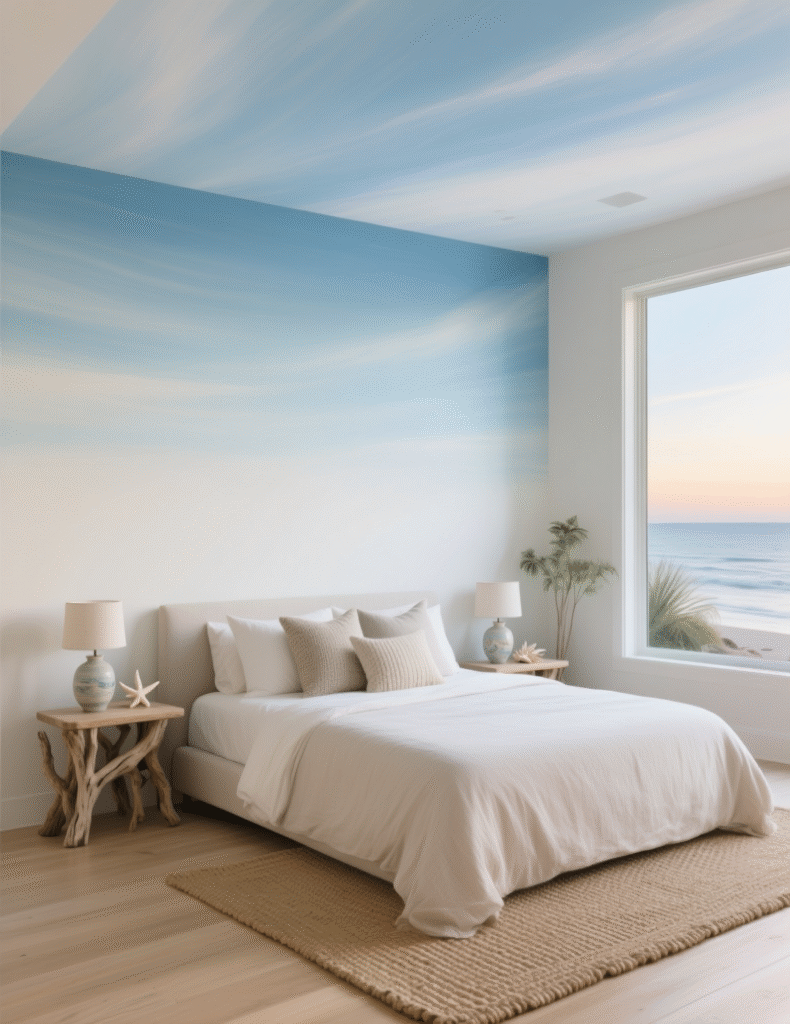
Most people forget the ceiling. But if you paint it a pale blue, it feels like lying under open air.
Pair it with white walls, and suddenly the whole room feels taller and lighter. You don’t need murals—just a wash of soft, sky-like color.
It’s a simple trick with a big emotional payoff.
20. Blend indoor and outdoor flow
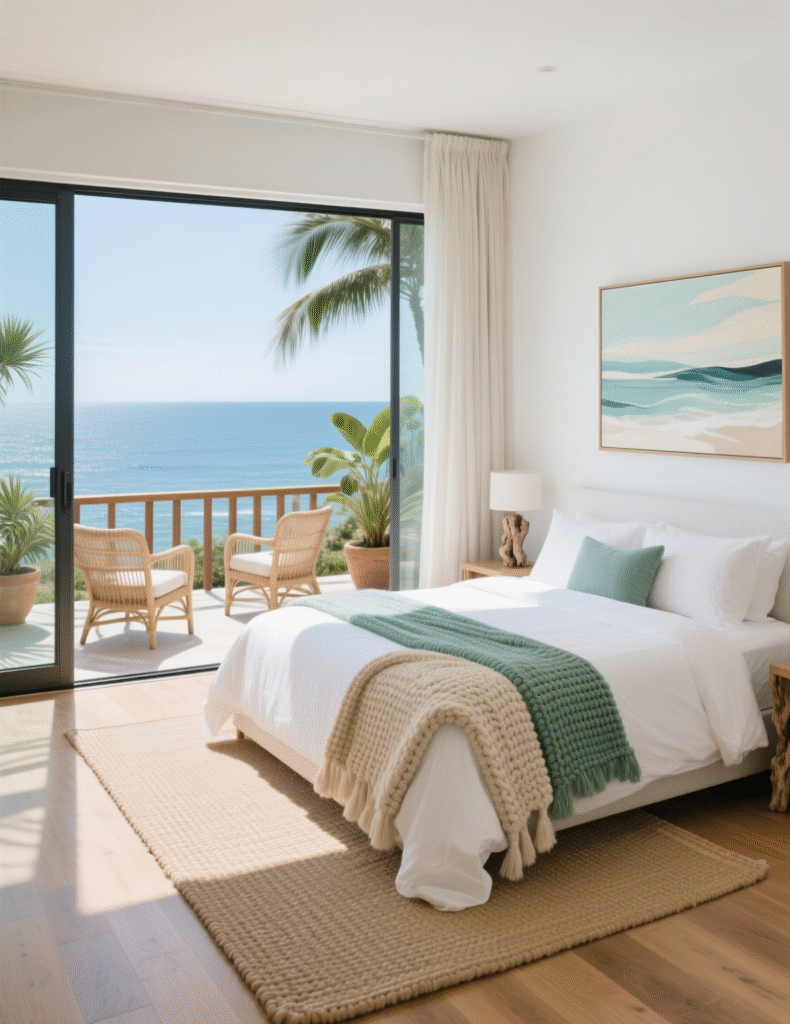
If your bedroom has a balcony or even just a big window, design the connection. Place a chair near the glass, keep curtains light, and add plants both inside and just outside.
The view becomes part of the room. Even if it’s not the ocean, the transition between inside and outside feels coastal.
A breeze through that open window does more than any decoration ever could.
Final Thoughts
Bringing the beach home isn’t about palm-tree wallpaper or seashell chandeliers. It’s about atmosphere. Soft colors, textures that feel real, light that moves with the day. It’s about walking in and feeling your shoulders drop, like you finally exhaled.
Even if you live in the middle of the city, you can sleep in a room that hums with the coast. Every morning, it will remind you of tide and sand, even if all you see outside is concrete. That’s the magic of design—it brings places to you.
And when the day ends, and you lay back on linen sheets with the window cracked open, you’ll hear it. The silence that feels like waves, the air that feels lighter. That’s how you know you’ve built more than a bedroom. You’ve built a retreat.

Emma is a passionate home decor enthusiast and the voice behind Home Evoke. With a keen eye for design and a love for transforming spaces, she shares her expertise and creative ideas to help others create beautiful, functional homes. Through her blog, Emma inspires readers with practical tips, trend insights, and DIY projects that make home styling effortless and enjoyable.

